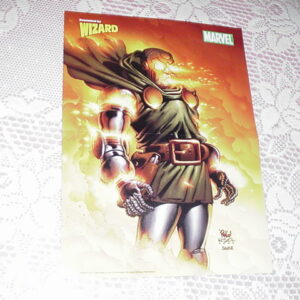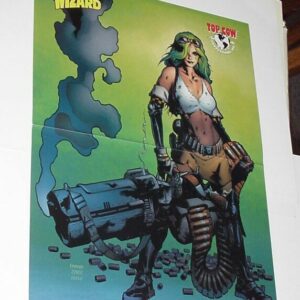Aliens Poster #62 Queen Alien – Amazing James Cameron Creation H.R. Giger
$49.99
Description
Aliens is a 1986 American science-fiction action horror film written and directed by James Cameron, produced by his then-wife Gale Anne Hurd, and starring Sigourney Weaver, Carrie Henn, Michael Biehn, Paul Reiser, Lance Henriksen, William Hope, and Bill Paxton. It is the sequel to the 1979 film Alien and the second installment of the Alien franchise. The film follows Weaver’s character Ellen Ripley as she returns to the planet where her crew encountered the hostile Alien creature, this time accompanied by a unit of space marines.
Brandywine Productions was interested in a follow-up to Alien as soon as its 1979 release, but the new management at 20th Century Fox postponed those plans until 1983. That year Brandywine picked Cameron to write after reading his script for The Terminator, and once that film became a hit in 1984, Fox greenlit Aliens, that would also be directed by Cameron, with a budget of approximately $18 million. The script was written with a war film tone influenced by the Vietnam War to contrast the horror motifs of the original Alien. It was filmed in England at Pinewood Studios and at a decommissioned power plant in Acton, London.
Aliens was a critical and commercial success, with positive reviews that considered it an entertaining film that despite the tonal shift still served as a worthy sequel to Alien, and grossed $180 million worldwide. The movie was nominated for seven Academy Awards, including a Best Actress nomination for Sigourney Weaver, winning both Sound Effects Editing and Visual Effects. It won eight Saturn Awards, including Best Science Fiction Film, Best Actress for Weaver and Best Direction and Best Writing for Cameron. Aliens is frequently considered one of the best action films ever released.
Aliens was nominated for seven Academy Awards including Best Music, Best Sound, Best Film Editing, and Best Art Direction/Set Decoration. It won two awards for Sound Effects Editing and Visual Effects. Sigourney Weaver received her first Academy Award nomination for Best Actress, and although she did not win, it was considered a landmark nomination for an actress to be considered for a science fiction/horror film, a genre which was given little recognition by the Academy in 1986.
Ripley and an injured Hicks reach Bishop and the second dropship, but Ripley refuses to leave Newt behind. She rescues Newt from the hive in the processing station, where the two encounter the Alien queen in her egg chamber. Ripley destroys the eggs, enraging the queen, who tears free from her ovipositor. Pursued by the queen, Ripley and Newt rendezvous with Bishop and Hicks on the dropship and escape moments before the colony is consumed by the nuclear blast. Back on the Sulaco, Ripley and Bishop’s relief at their escape is interrupted when the Alien queen, stowed away on the dropship’s landing gear, tears Bishop in two. Ripley battles the queen using an exosuit cargo-loader and expels it through an airlock. Ripley, Newt, Hicks and the badly-damaged Bishop then enter hypersleep for the return to Earth.
Aside from the Alien Queen, designed by Cameron himself, the Aliens still took inspiration off H. R. Giger’s designs for the original. The only change was removing the translucent dome that gave the creature’s head its sleek shape in Alien, exposing the ridged, spined cranium beneath. Cameron felt the dome was too fragile for the practical effects, and also felt that the cranium design was more visually interesting without it.
Scenes involving the Alien queen were the most difficult to film, according to production staff. A life-sized mock-up was created by Stan Winston’s company in the United States to see how it would operate. Once the testing was complete, the crew working on the queen flew to England and began work creating the final version. Standing at 14 feet tall, it was operated using a mixture of puppeteers, control rods, hydraulics, cables, and a crane above to support it. Two puppeteers were inside the suit operating its arms, and sixteen were required to move it. All sequences involving the full size queen were filmed in-camera with no post-production manipulation. Additionally, a miniature alien queen was used for certain shots.
Queen Aliens are significantly larger and stronger than the normal adults, being approximately 15 ft tall. Their body structure differs also, having two pairs of arms, one large and one small. The queen’s head is larger than those of other adult Aliens, male and female, and is protected by a large, flat crest, like a crown, which varies from queen to queen. In the second film Aliens, unlike other adults and queens, the queen had high-heel protrusions from her feet.
Egg-laying Alien queens possess an immense ovipositor attached to their lower torso, similar to a queen termite’s. Unlike insect queens, there appears to be no need for an Alien queen’s eggs to be fertilized. When attached to her ovipositor, the queen is supported by a “biomechanical throne” that consists of a lattice of struts resembling massive insect legs.
In the original cut of Alien, the Alien possessed a complete lifecycle, with the still-living bodies of its victims converted into eggs. However, the scene showing the crew converted into eggs was cut for reasons of pacing, leaving the ultimate origin of the eggs obscure. This allowed Aliens director James Cameron to introduce a concept he had initially conceived for a spec script called Mother, a massive mother Alien Queen which laid eggs and formed the basis for the Aliens’ life cycle. Cameron conceived the Queen as a monstrous analogue to Ripley’s own maternal role in the film. In that vein, some critics have compared it to Grendel’s mother.
The design of the queen was created by Cameron in collaboration with special effects artist Stan Winston, based upon an initial painting Cameron had done at the start of the project. The Winston Studio created a test foam core queen before constructing the full hydraulic puppet which was used for most of the scenes involving the large Alien. Two people were inside working the twin sets of arms and puppeteers off-screen worked its jaws and head. Although at the end of the film the queen was presented full-body fighting the power-loader, the audience never sees the legs of the queen, save those of the small-scale puppet that appears only briefly. In Aliens, Cameron used very selective camera-angles on the queen, using the ‘less is more’ style of photography. Subsequently the movie won an Oscar for Visual Effects. An adult queen was to reappear in Alien Resurrection. The original mechanical head previously used in Aliens was provided by Bob Burns, and was an altered design. It was repainted with a blend of green and brown, giving it a shimmering, insect-like quality. This color concept would be abandoned in Alien versus Predator in favour of the original black color scheme.
In the climax of the 2004 film Alien vs. Predator the queen’s basic design was altered to make her more “streamlined” in appearance and her over-all size was increased to 6 meters (20 feet) tall. Other changes include the removal of the “high-heel” protrusions on her legs, including additional spines on her head and making her waist thinner because there was no need for puppeteers inside her chest. The animatronic queen had 47 points of hydraulic motion.
Aliens vs. Predator: Requiem (2007) introduced a younger form of the full grown queen, albeit with traits inherited from its Predator host. Recalling the facehugger’s method of embryo implantation, the Predalien uses its inner mouth to directly deposit multiple chestburster embryos into pregnant female hosts, also using its mandibles to latch on the faces of said hosts. This is explained by the Brothers Strause as a means of quickly building an army of Aliens before the young queen evolves into its sedentary, egg-laying state.
Near mint condition.
Related products
-


Wolverine Poster #16 vs The Hand The End by David Finch Ninjas
$39.99 Add to cart -


Supreme Power Poster # 1 Joe Quesada Hyperion Doctor Spectrum Squadron
$29.99 Add to cart -


Doctor Doom Poster # 3 Triumphant by Mike Wieringo Fantastic Four 67
$34.99 Add to cart -


Aphrodite IX Poster # 2 by Trevor Hairsine Image
$29.99 Add to cart



